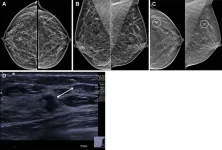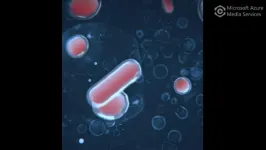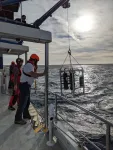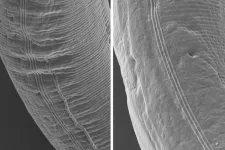(Press-News.org) OAK BROOK, Ill. – Ultrasound is an effective standalone diagnostic method in patients with focal breast complaints, according to a study published in Radiology, a journal of the Radiological Society of North America (RSNA). Focal breast complaints can refer to pain, lumps, nipple discharge or other symptoms and conditions confined to a specific area of the breast.
In women, focal breast complaints are a frequent problem. In the Netherlands, approximately 70,000 women visit radiology departments annually with focal breast complaints. The most common being the presence of lumps or pain. Many women who have focal breast complaints are between the ages of 30 and 50 years.
Digital breast tomosynthesis (DBT) followed by targeted ultrasound is the standard diagnostic tool for women 30 years or older with localized breast complaints. While DBT provides an overall image of both breasts, ultrasound can achieve more targeted imaging of a specific area of the breast. The quality of ultrasound images has also vastly improved in recent years.
For the new study, researchers set out to investigate the performance of ultrasound alone as an effective diagnostic method in women over the age of 30 who reported localized breast complaints at three hospitals in the Netherlands between September 2017 and June 2019.
“The evaluation of breast complaints is a common problem in breast diagnostics,” said study co-author Linda Appelman, M.D., a breast radiologist in the Department of Medical Imaging at Radboud University Medical Center in Nijmegen, the Netherlands. “Ultrasound as the first imaging method may provide clarity with regard to the focal breast complaint.”
Breast lumps or localized breast pain were two of the most common symptoms reported by the 1,961 women included in the study. A total of seven subgroups of focal complaints were recognized.
In all patients, targeted ultrasound was evaluated first, followed by DBT. Biopsy was performed after ultrasound, if needed. Since the ultrasounds were conducted first, the radiologists who participated in the study weren’t influenced by the DBT images when interpreting the ultrasounds.
Analysis showed that ultrasound alone led to accurate diagnosis in 1,759 (90%) of the 1,961 patients. Over 80% of the complaints ended up being normal or benign findings, such as cysts.
“We found that the diagnostic accuracy of ultrasound is high in women with focal breast complaints,” Dr. Appelman said.
A total of 374 patients had biopsies based on ultrasound findings alone. This resulted in 192 symptomatic breast cancer diagnoses.
Ultrasound of focal breast complaints may be especially beneficial in low- or middle-income countries where ultrasound is more readily available as opposed to DBT.
“Our study showed that ultrasound alone can effectively diagnose focal breast complaints in a large majority of women,” Dr. Appelman said. “In a setting with limited resources or an already existing screening program, initial ultrasound might be a better alternative compared to mammography.”
The cost effectiveness of ultrasound and the improved patient comfort during the procedure are other factors to consider when expanding its implementation in symptomatic breast cancer diagnosis.
###
“US and Digital Breast Tomosynthesis in Women with Focal Breast Complaints: Results of the Breast US Trial (BUST).” Collaborating with Dr. Appelman were Carmen C. N. Siebers, M.Sc., Peter T. M. Appelman, M.D., H. L. Shirley Go, M.D., Mireille J. M. Broeders, Ph.D., Marja C. J. van Oirsouw, Peter Bult, M.D., Ph.D., and Ritse M. Mann, M.D., Ph.D.
In 2023, Radiology is celebrating its 100th anniversary with 12 centennial issues, highlighting Radiology’s legacy of publishing exceptional and practical science to improve patient care.
Radiology is edited by Linda Moy, M.D., New York University, New York, N.Y., and owned and published by the Radiological Society of North America, Inc. (https://pubs.rsna.org/journal/radiology)
RSNA is an association of radiologists, radiation oncologists, medical physicists and related scientists promoting excellence in patient care and health care delivery through education, research, and technologic innovation. The Society is based in Oak Brook, Illinois. (RSNA.org)
For patient-friendly information on breast ultrasound, visit RadiologyInfo.org.
END
BALTIMORE, April, 4, 2023-- As more consumers turn to the newly available ChatGPT for health advice, researchers are eager to see whether the information provided by the artificial intelligence chatbot is reliable and accurate. A new study conducted by researchers at the University of Maryland School of Medicine (UMSOM) indicates that the answers generated provide correct information the vast majority of the time; sometimes, though, the information is inaccurate or even fictitious.
Findings were published today in the journal Radiology.
In February 2023, UMSOM researchers created a set of 25 questions related to advice on getting screened ...
A recent study in the Journal of Biological Chemistry revealed the key to a protein that commonly causes blindness. The biological process involves a protein that is essential for transporting toxic compounds out of the eye, similar to a garbage recycling service. The challenge is that, like food and the waste it generates, these compounds are essential for the eye to function properly — until they build up and cause blindness.
The scientists behind the study research a protein transporter, called ABCA4, that lines the edges of specialized photoreceptor cells in the retina and is normally poised to remove toxic, fatty retinal byproducts ...
In a study conducted in the lab as well as during the COVID-19 lockdowns, participants reported higher levels of tiredness after eight hours of social isolation. The results suggest that low energy may be a basic human response to a lack of social contact. The study conducted at the University of Vienna and published in Psychological Science also showed that this response was affected by social personality traits of the participants.
If we do not eat for an extended period, a series of biological processes ensue that create a craving sensation we recognize as hunger. As a social species, we also need other people to survive. Evidence shows that a lack of social contact induces ...
Insilico Medicine (“Insilico”), a clinical-stage generative artificial intelligence (AI)-driven drug discovery company, today announced that four abstracts have been accepted as poster presentations at the American Association for Cancer Research (AACR) Annual Meeting 2023.
Insilico will present four novel inhibitors for the treatment of cancer developed with its end-to-end Pharma.AI platform. Drawing from trillions of data points and millions of compounds and molecular fragments, the platform uses ...
Red tides, caused by Karenia brevis blooms, are a recurring problem in the coastal Gulf of Mexico. The organism, Karenia brevis, produces toxins that can cause fish kills, respiratory irritation in humans and cause death in sea turtles, dolphins, manatees and birds.
The ability to detect red tide blooms at all life stages and cell concentrations is critical to increasing predictive capabilities and developing potential mitigation strategies to protect public health and vital resources.
Current methods used to monitor red tide such as microscopic identification and enumeration, standard flow cytometry, as well as others have limitations. Some of these ...
April 4, 2023, TORONTO — Becoming the first genomics lab to be accredited by three of the leading North American accreditation organizations positions OICR Genomics to generate new discoveries about what drives diseases like cancer and new, personalized ways to diagnose and treat them.
The lab earned a Clinical Laboratory Improvement Amendments (CLIA) certificate of accreditation in January 2023 for its whole genome and whole transcriptome sequencing assay, a comprehensive genetic test that can find all changes in the DNA of a tumour. This comes after accreditation from the College of American Pathologists (CAP) in 2021 and from Accreditation Canada Diagnostics (ACD) — ...
SPOKANE, Wash.—Researchers have long known that many animals live longer in colder climates than in warmer climates. New research in C. elegans nematode worms suggests that this phenomenon is tied to a protein found in the nervous system that controls the expression of collagens, the primary building block of skin, bone and connective tissue in many animals.
Since the C. elegans’ protein is similar to nervous system receptor proteins found in other species including humans, the discovery potentially brings scientists closer to finding ways to harness collagen expression to slow down human aging and increase lifespan in the ...
In the United States alone, drug-resistant bacteria and fungi infect almost 3 million people per year and kill about 35,000. Antibiotics are essential and effective, but in recent years overuse has led to some bacteria developing resistance to them. The infections are so difficult to treat, the World Health Organization deemed antibiotic resistance a top 10 global public health threat.
Now, Professor John E. Moses at Cold Spring Harbor Laboratory (CSHL) has created a new weapon against these drug-resistant ...
Sixty per cent of the world's fresh water is bound up in Antarctic ice sheets. Thirty million cubic kilometres of ice is perhaps a difficult number to grasp. But if absolutely all Antarctica’s ice melted, the seas would rise by 58 metres on average.
“The ice sheet in East Antarctica stores enormous amounts of water. This means that this is the biggest possible source of future sea level rise – up to 53 meters if all of the East Antarctic ice melts – and is seen as the largest source of uncertainties in the ...
A research team at Chalmers University of Technology is the first to demonstrate a unique method that reduces the aerodynamic resistance of ships by 7.5 per cent. This opens the way for large cargo ships borne across the oceans by wind alone, as wind-powered ships are more affected by aerodynamic drag than fossil-fueled ones.
To hit international climate targets, the carbon emissions from shipping must be reduced by more than 50 per cent by 2050 compared to 2008 levels. As much as 99 per cent of global shipping is currently dependent on fossil fuels. Even though electricity may carry smaller ferries ...






